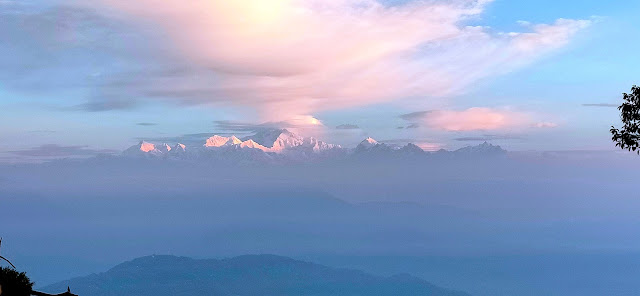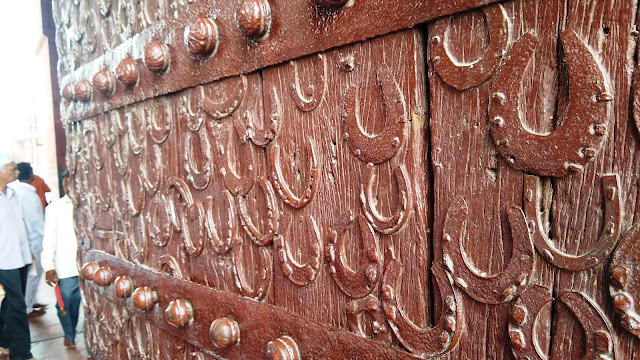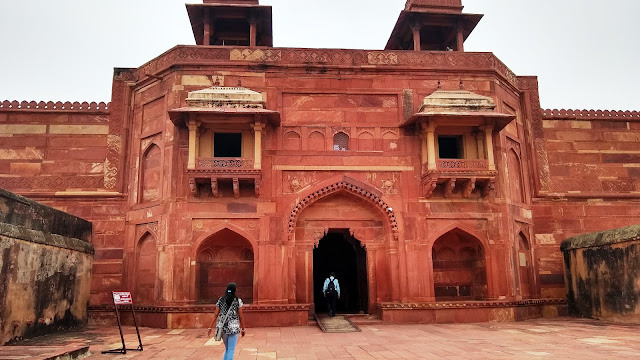Lepchajagat is a small village located in wilderness at an altitude of 6,956 ft and only 19kms away from Darjeeling hill town.
Lepchajagat is all about dense forested area full with Pines, Oaks and Rhododendrons. And all that is combined with magnificent views of Kanchenjunga peaks, wonderful birdlife and serene tranquility.
We took the shared jeeps from NJP towards Darjeeling that dropped us at Ghum. From there we took another shared jeep which dropped us near the lodge(Kanchan Kanya) at the main road. Most private homestays including Kanchan Kanya are located by the road side, so there won't be any walk involved.
You can get pre-paid taxis from NJP or Bagdogra for Lepchajagat. It takes about 2.5 hours to reach from NJP/Bagdogra (by the normal route - Hill Cart Road via Ghoom)
From Darjeeling (Chowk Bazaar stand), there are shared jeeps available which pass by the main road as well. If you do not get a direct shared taxi from Darjeeling, you can come up to Ghum and change to another one.
Jorpokhri (only about 5kms away), well known for its serene beauty and views of Kanchenjunga, a beautiful pond and the rare Himalayan Salamanders.
Located at an altitude of 7,400 ft, the main feature of Jorpokhi is its twin lakes after which the place has been named
One of the best offerings of Jorpokhri is its sweeping views of the Himalayan snow peaks and the Darjeeling landscape. On a clear day and from one side of the lake you can get breathtaking views of the majestic Kanchenjunga peaks. On the other side you can see Darjeeling and Kurseong town landscapes. You can spend hours watching the splendors.
The best season to get such view is between October to March. From one side of the lake a paved pathway leads to a stairway and on top there is a lovely shaded viewing area. This is the place to get the best views of the mountains, the beautiful landscaped gardens, the lake and the rows of pine trees.
Simana View Point
About 20 minutes from Sukhiapokhri, you will reach a wonderful view point called Simana - a 60 feet by 40 feet plateau and a viewing area. Simana in Hindi means border. This is the Indo-Nepal border area, the road itself belongs to India and the viewing area falls in Nepal. But you can freely cross over to get the views.
You can see Maneybhanjan below and the beautiful mountains on a clear day. You can also see the narrow winding road leading to Sandakphu on the other side of the valley. Look to your right and you can see the dazzling Kanchenjunga snow peaks.
Having visited Simana, as you move on further towards Mirik, you will come across lovely landscapes full of tea gardens on your left. There are several small round hillock formations with pine trees on top making it a picture perfect site. This is Gopaldhara Tea Estate. In fact you can walk down the isle through the tea gardens and reach a view point from where you get wonderful view of the gardens all around.
And here on the opposite side of the road is Gopadhara Tea Stall. Halt for a while to taste a cup of tea. The tea is prepared to perfection by a lady and served in a transparent cup so that you can see the color. If you haven't yet tasted green tea, this is the place to try that. But you should not mix milk or else you won't get the authentic flavor. The tea served here is from Gopaldhara Tea Gardens.
In fact you can also buy packaged tea of the gardens from here. I do so whenever I am traveling on this route. They have different brands... the black tea sold with maroon cover is good for getting colors as well as nice flavor. There is toilet facility here. The stall also sells packaged snacks.
Mirik
Mirik - A small hill town is located further 12kms from Pashupati Market and at an average altitude of 5,000ft. After reaching Mirik, first visit the Mirik Monastery on top and then the Mirik Lake. These are the top attractions of the place. There are separate bus and car parks on the right side of the lake on an open flat area.
Sit along the bank of the lake and relax. You can also do boating in the lake (mostly paddle boats). Or walk over the arching footbridge and crossover to the other side (western bank) of the lake, turn left and take the walkway through the dhupi forest and enjoy the nature. There is a temple in the forest (known as Devi Sthan). Pony rides are also available around the lake and quite popular with children.
Pashupati Market entrance at the India-Nepal border. The main market is about 1km walk from the border. You can either walk or take a Nepal taxi at the border to reach the main market (Rs. 200/- for round trip). Alternatively you can take your own vehicle, complete a vehicle permit formality at the border check post and pay the permit fee for the car (permit charge is around Rs. 350/- for a vehicle). There are few shops right across the border which you can check out in case you do not want to go all the way to the main market.
Once you complete formalities with the border security (which is usually a quick process), you will get to the road in Nepal that leads to the main market. This road continues all the way to Katmandu. Cameras are not allowed inside. Note that only Indians and Nepalese are allowed to cross over the border area here. Foreign nationals are not allowed to access this border. You are required to carry Photo ID in case you want to cross over the border and visit the shops. The market is full of imported electronic gadgets, jackets, perfumes & cosmetics, accessories and clothes. Be careful about the fakes. Many items sold here are too cheap to be good. You can also visit the market on your way back.
Fare updated: March 2020
Small reserved taxi fare from NJP/Siliguri/Bagdogra = Rs. 2,200 - 2,500/-
Small reserved taxi fare from Darjeeling = Rs. 800/-
Shared taxi fare from Darjeeling = Rs. 50/-
Shared taxi fare from NJP/Siliguri up to Ghum = Rs. 175 - 200/-
Shared taxi fare from Ghum up to Lepcha Jagat = Rs. 40/-
Lepchajagat is all about dense forested area full with Pines, Oaks and Rhododendrons. And all that is combined with magnificent views of Kanchenjunga peaks, wonderful birdlife and serene tranquility.
We took the shared jeeps from NJP towards Darjeeling that dropped us at Ghum. From there we took another shared jeep which dropped us near the lodge(Kanchan Kanya) at the main road. Most private homestays including Kanchan Kanya are located by the road side, so there won't be any walk involved.
You can get pre-paid taxis from NJP or Bagdogra for Lepchajagat. It takes about 2.5 hours to reach from NJP/Bagdogra (by the normal route - Hill Cart Road via Ghoom)
From Darjeeling (Chowk Bazaar stand), there are shared jeeps available which pass by the main road as well. If you do not get a direct shared taxi from Darjeeling, you can come up to Ghum and change to another one.
Jorpokhri (only about 5kms away), well known for its serene beauty and views of Kanchenjunga, a beautiful pond and the rare Himalayan Salamanders.
Located at an altitude of 7,400 ft, the main feature of Jorpokhi is its twin lakes after which the place has been named
One of the best offerings of Jorpokhri is its sweeping views of the Himalayan snow peaks and the Darjeeling landscape. On a clear day and from one side of the lake you can get breathtaking views of the majestic Kanchenjunga peaks. On the other side you can see Darjeeling and Kurseong town landscapes. You can spend hours watching the splendors.
The best season to get such view is between October to March. From one side of the lake a paved pathway leads to a stairway and on top there is a lovely shaded viewing area. This is the place to get the best views of the mountains, the beautiful landscaped gardens, the lake and the rows of pine trees.
Simana View Point
About 20 minutes from Sukhiapokhri, you will reach a wonderful view point called Simana - a 60 feet by 40 feet plateau and a viewing area. Simana in Hindi means border. This is the Indo-Nepal border area, the road itself belongs to India and the viewing area falls in Nepal. But you can freely cross over to get the views.
You can see Maneybhanjan below and the beautiful mountains on a clear day. You can also see the narrow winding road leading to Sandakphu on the other side of the valley. Look to your right and you can see the dazzling Kanchenjunga snow peaks.
Having visited Simana, as you move on further towards Mirik, you will come across lovely landscapes full of tea gardens on your left. There are several small round hillock formations with pine trees on top making it a picture perfect site. This is Gopaldhara Tea Estate. In fact you can walk down the isle through the tea gardens and reach a view point from where you get wonderful view of the gardens all around.
And here on the opposite side of the road is Gopadhara Tea Stall. Halt for a while to taste a cup of tea. The tea is prepared to perfection by a lady and served in a transparent cup so that you can see the color. If you haven't yet tasted green tea, this is the place to try that. But you should not mix milk or else you won't get the authentic flavor. The tea served here is from Gopaldhara Tea Gardens.
In fact you can also buy packaged tea of the gardens from here. I do so whenever I am traveling on this route. They have different brands... the black tea sold with maroon cover is good for getting colors as well as nice flavor. There is toilet facility here. The stall also sells packaged snacks.
Mirik
Mirik - A small hill town is located further 12kms from Pashupati Market and at an average altitude of 5,000ft. After reaching Mirik, first visit the Mirik Monastery on top and then the Mirik Lake. These are the top attractions of the place. There are separate bus and car parks on the right side of the lake on an open flat area.
Sit along the bank of the lake and relax. You can also do boating in the lake (mostly paddle boats). Or walk over the arching footbridge and crossover to the other side (western bank) of the lake, turn left and take the walkway through the dhupi forest and enjoy the nature. There is a temple in the forest (known as Devi Sthan). Pony rides are also available around the lake and quite popular with children.
Pashupati Market entrance at the India-Nepal border. The main market is about 1km walk from the border. You can either walk or take a Nepal taxi at the border to reach the main market (Rs. 200/- for round trip). Alternatively you can take your own vehicle, complete a vehicle permit formality at the border check post and pay the permit fee for the car (permit charge is around Rs. 350/- for a vehicle). There are few shops right across the border which you can check out in case you do not want to go all the way to the main market.
Once you complete formalities with the border security (which is usually a quick process), you will get to the road in Nepal that leads to the main market. This road continues all the way to Katmandu. Cameras are not allowed inside. Note that only Indians and Nepalese are allowed to cross over the border area here. Foreign nationals are not allowed to access this border. You are required to carry Photo ID in case you want to cross over the border and visit the shops. The market is full of imported electronic gadgets, jackets, perfumes & cosmetics, accessories and clothes. Be careful about the fakes. Many items sold here are too cheap to be good. You can also visit the market on your way back.
Fare updated: March 2020
Small reserved taxi fare from NJP/Siliguri/Bagdogra = Rs. 2,200 - 2,500/-
Small reserved taxi fare from Darjeeling = Rs. 800/-
Shared taxi fare from Darjeeling = Rs. 50/-
Shared taxi fare from NJP/Siliguri up to Ghum = Rs. 175 - 200/-
Shared taxi fare from Ghum up to Lepcha Jagat = Rs. 40/-































































